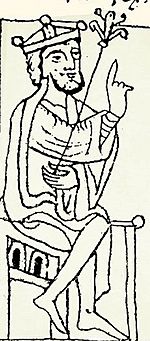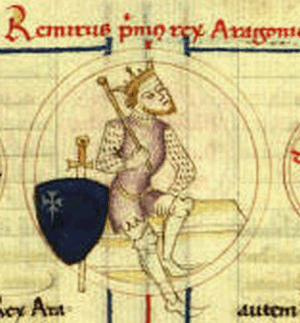Ramiro I of Aragon facts for kids
Quick facts for kids Ramiro I of Aragon |
|
|---|---|

13th century miniature of Ramiro
|
|
| King of Aragon | |
| Reign | 1035 - 1063 |
| Successor | Sancho Ramírez |
| Born | before 1007 |
| Died | 8 May 1063 (aged 55–56) Graus |
| Burial | Royal Monastery of San Juan de la Peña |
| Spouse | Ermesinda of Bigorre Agnes |
| Issue |
|
| House | House of Jiménez |
| Father | Sancho III of Pamplona |
| Mother | Sancha of Aybar |
Ramiro I (born before 1007 – died May 8, 1063) was the very first King of Aragon. He ruled from 1035 until his death. Sometimes, people called him a "petty king" because his kingdom was quite small at first. Ramiro worked hard to make his new Kingdom of Aragon bigger. He added new lands like Sobrarbe and Ribagorza, and the important city of Sangüesa. His son, Sancho Ramírez, took over after him. Sancho became King of Aragon and also King of Pamplona.
Contents
The Life of Ramiro I
Early Life and Family
Ramiro was born before the year 1007. He was the son of Sancho III of Pamplona, who was a powerful king. Ramiro's mother was a woman named Sancha of Aybar. There's a story that King Sancho's wife, Muniadona, adopted Ramiro. The story says he was the only one of Sancho's children who helped her when she needed it. However, there are no old records to prove this story, so it's probably not true.
Ramiro started appearing in official royal papers around 1011. This shows he was involved in his father's court. He was given many properties in the area that would become Aragon.
Becoming a Ruler
When his father, King Sancho III, died in 1035, his large kingdom was divided among his sons. Ramiro received the area of Aragon. He was given the title of baiulus, which means a manager or steward.
This division of the kingdom was a big event:
- Ramiro's oldest half-brother, García, received Navarre and the Basque country.
- Another half-brother, Ferdinand, received the county of Castile.
- The counties of Sobrarbe and Ribagorza went to Gonzalo.
- Ramiro received lands in Aragon, but he was supposed to hold them under García's rule.
Ramiro's Royal Status
Ramiro's exact position was a bit unclear. His own people, his neighbors, and even his sons called him "king." But Ramiro himself always signed documents as "Ramiro, son of King Sancho."
In his two wills, he said that his lands were given to him to manage. In one will, he said García gave them to him. In the other, he said God gave them to him. In documents from Navarre, he was called regulus, which means "little king," instead of rex (king). He was also described as "acting as if king." Because his lands were small and in the Pyrenees mountains, he was sometimes called a "petty king." Aragon was seen as a "pocket kingdom" at this time.
Expanding the Kingdom
Ramiro wanted to make his lands bigger. He aimed to take land from both the Moors (Muslim rulers) and his brother García, the King of Navarre.
Soon after his father died (around 1036 to 1043), Ramiro supported the ruler of Tudela in an attack on Navarre. Ramiro lost the Battle of Tafalla, but he still managed to gain some land, including the city of Sanguesa. This helped him become more independent.
In 1043, Ramiro took over Sobrarbe and Ribagorza. These areas had belonged to his youngest legitimate half-brother, Gonzalo. This joining of lands created a state that was almost independent. It had its capital at Jaca. This was a big step in forming the future Kingdom of Aragon.
After adding Ribagorza and Sobrarbe, Ramiro began to move his forces towards the cities of Huesca and Zaragoza. He also created the first official rules for the royal town of Jaca. These rules protected everyone, even people who didn't live there. They became an example for city laws throughout the Middle Ages.
Death and Burial
Ramiro died in the Battle of Graus in 1063. He was trying to capture the city at the time. He was buried at the Royal Monastery of San Juan de la Peña, in Santa Cruz de la Serós.
Marriage and Children
Before he married, Ramiro had a son named Sancho with a woman named Amuña. Ramiro trusted this son to govern the county of Ribagorza.
Ramiro's first wife was Gisberga. She was the daughter of Bernard Roger of Bigorre. They married on August 22, 1036. When she married Ramiro, she changed her name to Ermesinda. They had five children together:
- Sancho Ramírez, who became king after his father.
- García, Bishop of Jaca, who became a bishop.
- Sancha, who married Armengol III of Urgel in 1065.
- Urraca, who became a nun in Santa Cruz de la Serós.
- Theresa, who married William Bertrand of Provence.
Ramiro's second wife was Agnes (also called Inés). She might have been the daughter of the Duke of Aquitaine. They did not have any children together.
Sources
|
Ramiro I of Aragon
House of Jiménez
Born: before 1007 Died: 8 May 1063 |
||
| Regnal titles | ||
|---|---|---|
| New title | King of Aragon 1035–1063 |
Succeeded by Sancho Ramírez |
See also
 In Spanish: Ramiro I de Aragón para niños
In Spanish: Ramiro I de Aragón para niños



